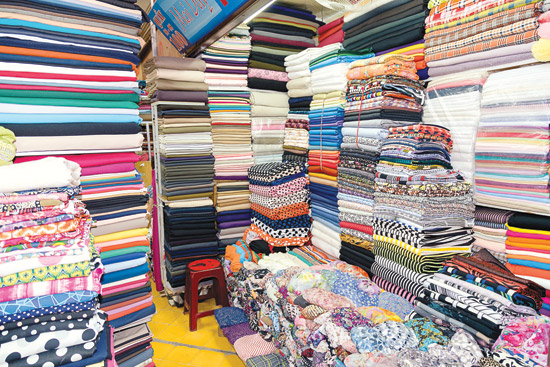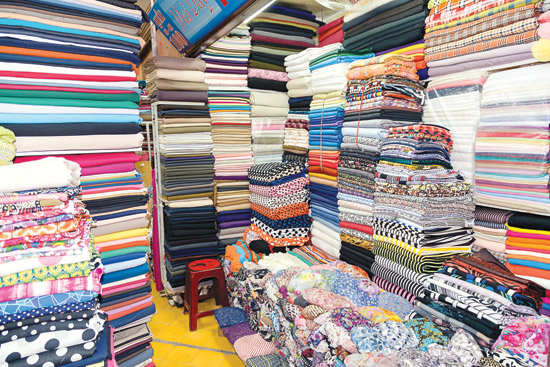(No.8, Vol.4,Sep-Oct 2014 Vietnam Heritage Magazine)

Farbics at Hom Market at the corner of Pho Hue and Tran Xuan Soan

Tailors at work
A fast way to get immersed in the midst of Vietnamese culture is to visit markets. And you are in luck, because Vietnam has a lot of them. Everywhere you go there are markets, indoor markets, outdoor markets, river markets, flower markets, ethnic markets.
Once there, your eyes have to adjust to all those colours, your nose has to adjust to all those smells and your brain is probably working hard trying to figure out what everything is. Take a regular fruit stand, where I am unable to name half of the fruits; I never knew there were so many different mushrooms, let alone all the different sorts of rice. And what do they do with those turtles? The fish stand certainly looks really different from the fish stand at home. You want chicken? Wait, let me unplug it for you first. How many geese can there be in one basket? Do they sell that buffalo? That boat is gonna sink under the weight of all those melons. For some it might be a little different, but for millions of Vietnamese people this is where the regular groceries are bought.
FABRIC MARKET
A dream for a lot of women might be the fabric market. Imagine hundreds of stands with thousands of fabrics and patterns. Walking around surrounded by fabrics shouting at you: ‘Pick me, pick me!’ and resisting the urge to lie down and take a nap in those heaps of fabric. It is easy to get lost between those similar looking stands, looking for the perfect material.
The people on the market are friendly, helpful and not pushy. They let you walk, assist you if you want to feel a fabric or fold it out to see how it looks, and tell you how many meters of it you’ll need for the clothes you want to have done with it.
For four dollars a metre and the low cost of tailors in Hanoi, you can easily get your perfect dress for less than $20 (VND400,000) and a nice tailored shirt for less than $15 (VND300,000). Yes! It is that cheap! You can bring a piece you love and have it made the exact same way, or you can find the perfect piece on the Internet and show some pictures to have it made in the same way.
HANOI vs HOI AN
A lot of people say: ‘When you go to Hoi An, you should have some clothes done!’ And you should, if you want to. Hoi An is a mecca for shoppers and there are a lot of tailors to choose from. Probably half of the shops there are tailors. And they are fast! But if you have the time also consider having clothes done in Hanoi. It takes a bit longer, but there are a couple of advantages.
1. You can pick your own fabrics, which is fun to do in itself:
Going to the market to buy your own fabric is a lot cheaper. You only pay around $4 (VND80,000) (maybe $5 (VND100,000) if you are less of a bargainer) a metre. You can get the materials you want and you are not bound to the selection they have in a shop. You can find fabric for jeans, suits, shorts, dresses, shirts, skirts, trousers, sweatpants, pretty much everything you want.
2. It is a lot cheaper:
Having a shirt made in Hoi An costs at least $35 (VND700,000). And if you want to have better quality it can go up to $60 (VND1,200,000). In Hanoi, you pay a little less than $15 (VND300,000) and the quality is good. For a dress in Hoi An, the price depends on the length etc, but it will be around $35 (VND700,000). In Hanoi it is a little less than $20 (VND400,000), maybe $21 (VND420,000) with a tip.
3. Tailors take more time to make it:
This can be an advantage and a disadvantage. The plus is they won’t rush it, which probably makes the result better. They have more time to spend on the details and they have more time to double-check it. On the negative side, you need to hang around in Hanoi a bit more. It takes about 10 days to have three pieces made. If you want to have clothes done, think about what you want before you go to Vietnam. Gather some pictures or take the thing you want to have duplicated with you. Go to the market on the first or second day you are in Hanoi. If you find a nice fabric, go to the tailor on that same day. The next day, you can travel to Halong Bay, after that to Sapa, visit Tam Coc and take a day trip to the pottery village for example. You could also visit the bamboo village, or the perfume pagoda. A lot of things to do in North Vietnam and before you know it those ten days are over!
The advantage of Hoi An is that the tailors are a lot more used to tourists, so their English is quite a lot better. The tailors in Hanoi speak only a little English, as in really little. But with pictures and a measure lint one can communicate surprisingly well. And in Hoi An they have more examples, they have tons of pictures in books you can choose from and there are a lot of clothes hanging in the store. The last plus is that they are faster; it only takes three days to make a suit for instance. If you only have little time to spend in Vietnam this could come in quite handy. In any case it’s going take some time; you need to have your measurements taken and get clear what it is that you want and then fitting and possibly adjusting something.
WHERE TO GO
The dress for less than $20 (VND400,000)
While in Hanoi you want to spend some time visiting markets anyway. It is recommended you get a little bit out of the tourist area and visit some a little further away. You could visit the flower market in the early morning for instance. The market in the Old Quarter is also nice to walk around, but a lot more touristy. There is a market a km or two south of the Old Quarter, where daily groceries are bought and conversations are made. The fabric market is on top of this market. You can visit both while you are at it. Buy some fruit at a vegetable stand; they don’t have a lot of choice, but it is half the price than at a fruit stand, about 10,000 dongs for a pineapple ($0.50) compared to VND30,000 ($1,50) for the same thing at the fruit stand. If you don’t want to have clothes made, you can still go upstairs to visit the fabrics. It is a nice experience anyways.
The market with the fabric is at the corner of Pho Hue and Tran Xuan Soan. You could walk there from Old Quarter or take a xe om (motorbike taxi). There are some tailors at the beginning of (Ngo) Thong Phong, really close to the temple of literature.
Happy tailoring!

